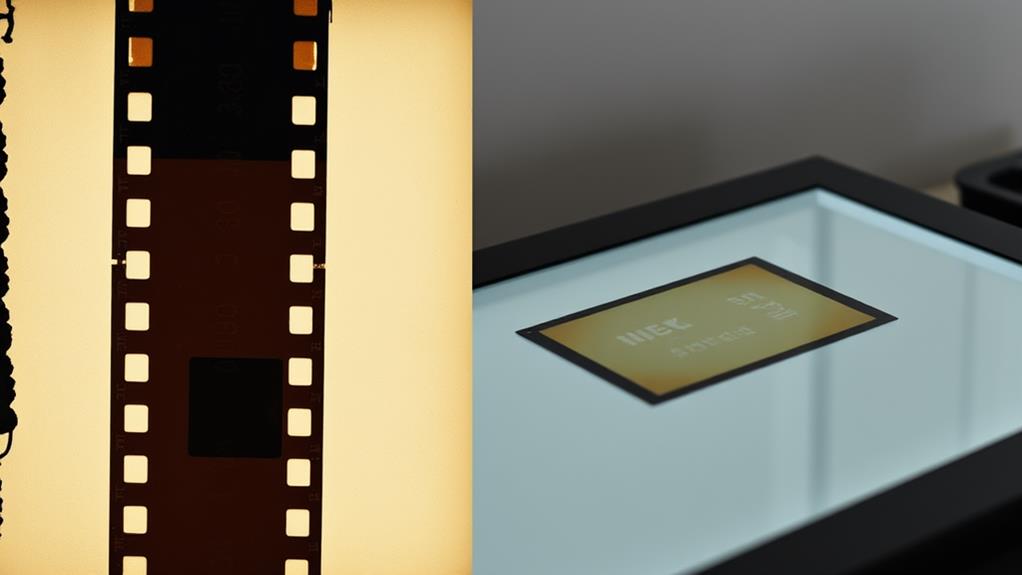Can You Scan Film on Any Scanner?
Not all scanners are created equal in terms of scanning film, and the quality of your digitized images heavily depends on the type of scanner you use. Dedicated film scanners offer superior results, while flatbed scanners can struggle with film scanning, leading to subpar quality due to limitations such as limited depth of field, risk of film damage, and unwanted reflections. Hybrid scanners and digital cameras with film scanning adapters provide alternative options, but choosing the right scanner depends on factors like film type, desired resolution, and budget. Understanding these differences is vital for achieving high-quality film digitization.
We are supported by our audience. When you purchase through links on our site, we may earn an affiliate commission, at no extra cost for you. Learn more. Last update on 27th June 2025 / Images from Amazon Product Advertising API.
Understanding Film Scanning Basics
Film scanning, a crucial step in the digitalization of analog film, involves the conversion of physical film frames into digital images. This process requires specialized equipment and software to accurately capture the nuances of the original film. The scanning process typically involves placing the film on a scanning bed or in a film holder, and then using a light source to illuminate the film. The scanner's sensors then capture the image, which is subsequently processed and refined through software. The resulting digital image can then be edited, shared, and preserved for future generations. Understanding the basics of film scanning is essential for achieving high-quality digital conversions that preserve the integrity of the original film.
Scanner Types for Film Digitization
Through the lens of digitization, the type of scanner used plays a pivotal role in capturing the essence of analog film, as it directly impacts the quality and accuracy of the resulting digital image. The choice of scanner is vital in ensuring that the digitized film meets the desired standards.
- Dedicated film scanners: Designed specifically for film scanning, these scanners offer high-quality results with precise control over settings.
- Flatbed scanners: While not ideal for film scanning, some flatbed scanners come with film scanning capabilities.
- Drum scanners: High-end scanners used for professional applications, offering exceptional image quality.
- Digital cameras with film scanning adapters: A cost-effective alternative for casual scanning needs.
- Hybrid scanners: Combining flatbed and film scanning capabilities in one device.
Limitations of Flatbed Scanners
While dedicated film scanners and drum scanners are designed to tackle the nuances of film digitization, flatbed scanners, although capable of scanning film, are not without their limitations. One major constraint is the limited depth of field, which can result in blurry or distorted images, particularly when scanning thicker film formats like 120 or 220. Additionally, flatbed scanners often struggle to handle the delicate nature of film, risking damage or scratches during the scanning process. Regular cleaning of your ice maker maintains peak performance and prevents bacterial growth, much like how regular maintenance of your scanner can prevent damage to your film. In addition, the scanner's light source can also cause unwanted reflections or glare on the film, compromising image quality. Moreover, these limitations can lead to subpar scan results, making flatbed scanners less than ideal for high-quality film digitization.
Dedicated Film Scanners Explained
In the domain of film digitization, dedicated film scanners stand out as the ultimate solution for achieving exceptional image quality and precision. These scanners are specifically designed to handle the unique demands of film scanning, offering superior results compared to flatbed scanners. They typically use a dedicated light source designed for film, ensuring ideal illumination and reduced noise. High-quality optics and precision lenses minimize distortion and capture every detail. Advanced algorithms and software correct for film grain, dust, and other imperfections. Many dedicated film scanners support multiple film formats, including 35mm, 120, and 4×5. Some high-end models even offer advanced features like infrared cleaning and scratch removal. In terms of precision, laser light accuracy is pivotal, and dedicated film scanners deliver. Additionally, features like rechargeable batteries or long-lasting batteries are convenient and cost-effective, making the scanning process more efficient.
Choosing the Right Scanner
When venturing into the world of film digitization, selecting the right scanner is a crucial decision that can make all the difference in achieving exceptional image quality and precision. Factors to weigh include the type of film you plan to scan, desired resolution, and budget. Dedicated film scanners offer superior quality and are ideal for high-volume scanning, while flatbed scanners with film-scanning capabilities provide a more affordable entry point. Additionally, ponder the scanner's optical resolution, dynamic range, and ability to handle various film formats. With the rise of outdoor enthusiasts and hunters using game cameras like SPYPOINT LINK-MICRO-LTE, it's imperative to research and compare different scanner models to find one that meets your specific needs. Researching and comparing different scanner models will help you make an informed decision and guarantee the best possible results for your film digitization project.

